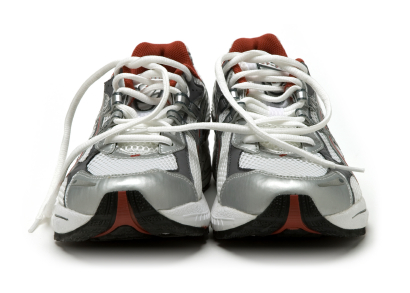These steps only take a few seconds and you can do them at home. They’re not 100% essential but when you come to buy your shoes this info might be handy – you’ll have a general idea of what you may be looking for, know what the heck the salesman is on about when he throws in “under/over pronation” and can narrow down your options.
Under-Pronation and Over-Pronation
First step. Grab an old pair of shoes, place them on a flat surface and take a look at them from behind. What we’re looking for here is any noticeable diagonal wearing away at the heel which will indicate your pronation. Pronation is the movement your foot makes when walking or running. This is important because over large distances and on hard surfaces putting too much pressure on one part of your foot can cause injury and you might need a shoe that can compensate for this by giving you better motion control or more cushioning.
Most runners will ‘over pronate’, so as your heel strikes the ground it’ll roll inwards to absorb the shock (indicated with a wearing of the heel on the inside). That’s not always the case though – if you 'under pronate' your feet don’t absorb the shock quite as much (wearing on the outside of the shoe) and you’ll likely want a shoe with more cushioning. Balanced wearing means that ‘biomechanically’ your footfalls are efficient (good for you) and stability is what you’re looking for.
The wet testSecond step is something called the wet test. Grab yourself a piece of brown cardboard and as you jump out of your next bath or shower leave an imprint of your foot on it. This will give you a general idea of your foot rests when flat on the ground and what you might want from your running shoe.

Normal foot – Your typical kind of footprint indicating a normal sized arch with the heel and forefoot broadly connected. Odds are the kind of running shoe you’ll want is one that focuses on stability with minimal motion control.
High arched foot – When all that’s shown is the fore foot and heel and only a thin connection between the two. Shoes that provide a high amount of cushioning (and therefore more shock absorption as the foot hits the ground) are likely needed here.



No comments:
Post a Comment